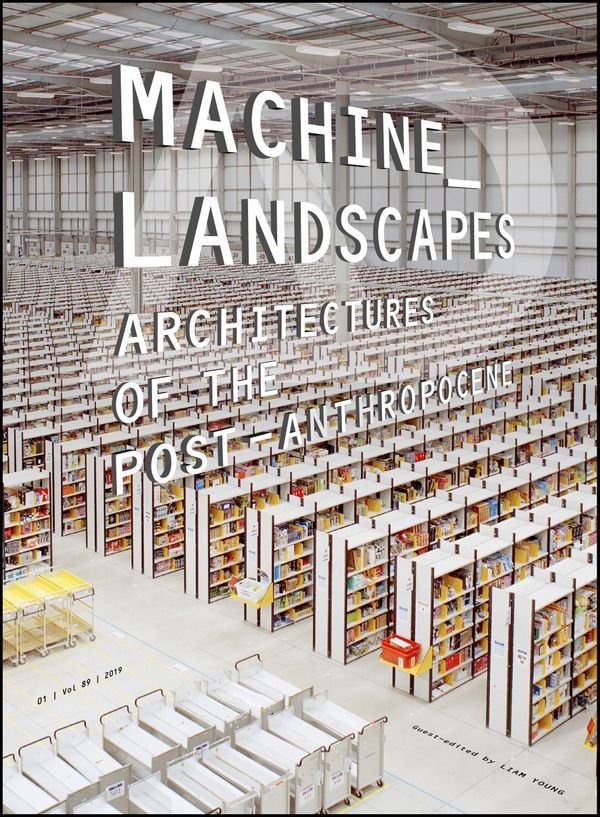Architectural Design, 89(1): Machine Landscapes: Architectures of the Post‐Anthropocene (2019)
Filed under magazine | Tags: · anthropocene, architecture, data center, design, infrastructure, machine, media infrastructure

“This issue of Architectural Design (AD) discusses how the most significant architectural spaces in the world are now entirely empty of people. The data centers, telecommunications networks, distribution warehouses, unmanned ports, and industrialized agriculture that define the very nature of who we are today are at the same time places we can never visit. Instead, they are occupied by server stacks and hard drives, logistics bots and mobile shelving units, autonomous cranes and container ships, robot vacuum cleaners and internet-connected toasters, driverless tractors and taxis.
This issue is an atlas of sites, architectures, and infrastructures that are not built for us, but whose form, materiality, and purpose are configured to anticipate the patterns of machine vision and habitation rather than our own. We are said to be living in a new geological epoch, the Anthropocene, in which humans are the dominant force shaping the planet. This collection of spaces, however, more accurately constitutes an era of the Post-Anthropocene, a period where technology and artificial intelligence now compute, condition, and construct our world. Marking the end of human-centred design, the issue turns its attention to the new typologies of the post-human, architecture without people, and our endless expanse of Machine Landscapes.”
Contributors: Liam Young, Benjamin H. Bratton, Trevor Paglen, Adam Harvey, Jenny Odell, Geoff Manaugh, Ben Roberts, Jesse LeCavalier, John Gerrard, Rem Koolhaas, Ingrid Burrington, Xingzhe Liu, Merve Bedir, Jason Hilgefort, Simone C. Niquille, Tim Maughan, Clare Lyster, Alice Gorman, Ian Cheng, Cathryn Dwyre, Chris Perry, David Salomon, and Kathy Velikov.
Edited by Liam Young
Publisher Wiley, January/February 2019
Open access
ISSN 0003-8504
ISBN 9781119453017
144 pages
Amodern, 8: Translation-Machination (2018)
Filed under journal | Tags: · language, machine, machine learning, media, technique, translation

“Amodern 8 explores the contexts and implications of translation as mechanism, media, technique, and transmission. Our tethering of “translation” to “machination” marks our intention to move beyond the habit of situating MT and computer-generated language in the familiar crisis poses of fakery, treason, and inauthenticity. Rather than regarding the machine as marking the limits of translation – an assumption that risks walling off translation practice from media and communication studies concerns, while still absorbing its products – our aim is to continue to investigate the possibilities and configurations of translation as machined, and translation as machining meaning, historically and in the contemporary moment.”
With contributions by Rita Raley, Otso Huopaniemi, John Cayley, Christine Mitchell, Tiffany Chan, Mara Mills, Jentery Sayers, Avery Slater, Quinn DuPont, Andrew Pilsch, Nick Montfort, Jane Birkin, Karin Littau, and Joe Milutis.
Edited by Christine Mitchell and Rita Raley
Publisher Concordia University and Lakehead University, January 2018
Creative Commons Attribution-Non Commercial 3.0 Unported License
Neda Atanasoski, Kalindi Vora: Surrogate Humanity: Race, Robots, and the Politics of Technological Futures (2019)
Filed under book | Tags: · artificial intelligence, automation, capitalism, colonialism, ethics, feminism, labour, liberalism, machine, military, race, robotics, robots, technology, women, work

“In Surrogate Humanity Neda Atanasoski and Kalindi Vora trace the ways in which robots, artificial intelligence, and other technologies serve as surrogates for human workers within a labor system entrenched in racial capitalism and patriarchy. Analyzing myriad technologies, from sex robots and military drones to sharing-economy platforms, Atanasoski and Vora show how liberal structures of antiblackness, settler colonialism, and patriarchy are fundamental to human—machine interactions, as well as the very definition of the human. While these new technologies and engineering projects promise a revolutionary new future, they replicate and reinforce racialized and gendered ideas about devalued work, exploitation, dispossession, and capitalist accumulation. Yet, even as engineers design robots to be more perfect versions of the human—more rational killers, more efficient workers, and tireless companions—the potential exists to develop alternative modes of engineering and technological development in ways that refuse the racial and colonial logics that maintain social hierarchies and inequality.”
Publisher Duke University Press, Durham, NC, March 2019
Perverse Modernities series
ISBN 9781478003861, 1478003863
x+240 pages
Interview with authors: Lesia Pagulich, Tatsiana Shchurko (Feminist Critique, 2019).
Reviews:Sibille Merz (Ethnic & Racial Studies, 2019), Barbara Herr Harthorn (American Ethnologist, 2020), Anita Lam (Surveillance & Society, 2020), Andrea Flores (Information & Culture, 2020), Raquel Bosó Pérez (Sociology of Health & Illness, 2020), Nina Trige Andersen (Modern Times, c.2020), Kevin Pabst (Security Journal, 2020).
Comment (0)
